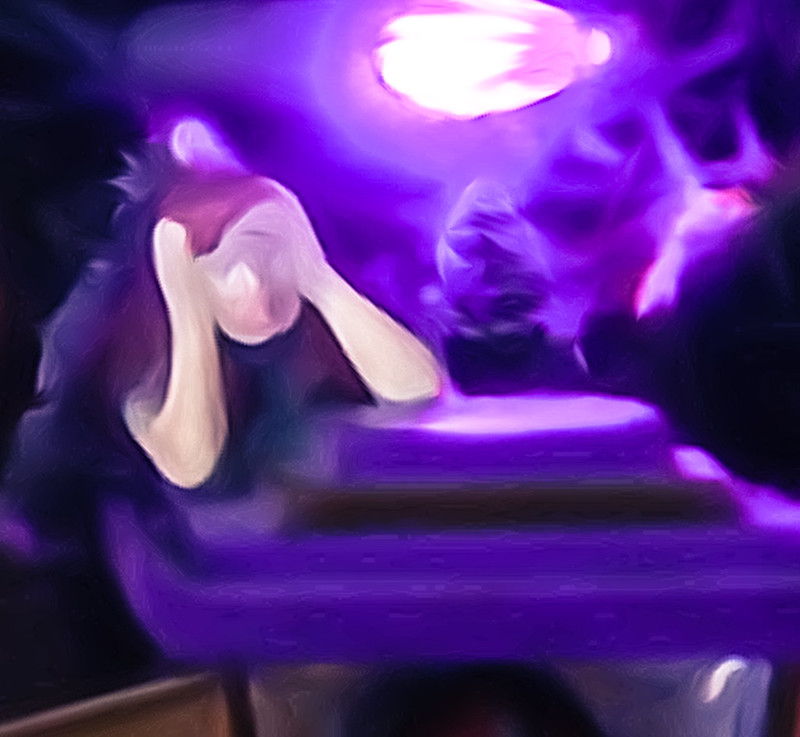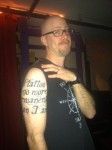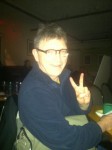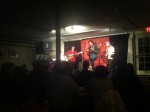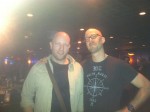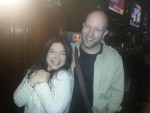I was in Pasadena, California, looking after a cat for a friend of mine. What I had initially embraced as a writing retreat quickly became a nightmare. I was trying to write at a desk in the living room when my back went into spasm, causing me worrying pain. Trying to distract myself, I opened Netflix and watched a new documentary about cancer.
Until then, I had thought the several months of off-and-on back pain was the result of an injury—a musculoskeletal issue from running or riding a motorcycle, perhaps—but my anxiety over the pain’s chronicity had been growing. Partway through the documentary, the angst reached a fever pitch. Fueled, no doubt, by the documentary’s subject matter, I became convinced that I had a tumor in my spine. I was sure of it. I now had cancer. The idea filled me with dread. My mind raced with possibilities, and I began hyperventilating. I was having a panic attack.
It had been nearly a year since I moved to Southern California to explore screenwriting after I quit my science writing job in Cambridge, Massachusetts. In that time, I had gone from a high-functioning working professional to a hypochondriac—obsessed with every ache and pain and overwhelmed by the fear of illness. As a freelance writer in California, I didn’t have a steady income and obtaining health insurance was a nightmare. Everyday questions about the most basic things spiraled through my head: Will I run out of money? Will my insurance cover that X-ray of my lower back? Am I going crazy? Bouts of grinding back pain evolved into a free-floating angst. I was chronically on edge and reacted strongly to perceived threats. My nervous system felt stuck in the “on” position.
Unsurprisingly, I was finding it difficult to break into screenwriting, and the way I had gone about trying to do so was romantic and unrealistic. The first screenplay I wrote had won second place in a contest and received favorable reviews from a couple of members of the industry, yet I was halfway through my second screenplay when I arrived in California and couldn’t push away an existential angst that I was doomed to fail. I felt the impossibility—the futility—of building a career in the movie business. I got the impression that I could write for ten years and never get anywhere.
Curiously, I had moved to California to write for the screen, and all I ended up writing was essays and journalism. What was I doing? I should have been in Boston writing for businesses and working on a novel. Instead, I had quit a job at a prestigious biomedical research institute in Cambridge, where I’d written for biomedical scientists from MIT and Harvard. I was untethered from the workforce, making trips to social services in Compton to secure health insurance and using food stamps to buy food. I was “following my dreams,” to be sure, but it had left me poor and dependent. Having always prided myself on self-reliance, I was disturbed by such vulnerability. I wasn’t in complete control anymore. Things were uncertain. I had always striven to be a somebody; now I was a nobody.
Months before Pasadena, I had visited my primary care physician in Long Beach, California, thinking I had strained a muscle in my back during a hard run on treadmill. I called to check on the results of an X-ray of my spine. The eighty-year-old physician read me the radiology report over the phone.
“It says you have an L5 retrolisthesis.”
“What does that mean?” I asked, concerned.
“The report says your lowest lumbar vertebra, L5, has slipped backward five millimeters.”
More worried, I asked, “What does that mean?”
“I don’t know exactly, but I’ll refer you to a back specialist.”
“What should I do in the meantime?”
“Maybe try a back brace?” he suggested.
Wait a minute, I thought. I’m thirty-three years old, with no history of mental or physical problems, a life-long athlete, and now I need a back brace? As many of us often do, I turned to the Internet. I read about “retrolisthesis” and obsessed over my radiology report. After reading about disc degeneration, ruptured and herniated discs, misalignments of vertebra, fractures, arthritis, spinal cord tears, and spinal instability, I began to invent worst-case scenarios. As I descended into neurosis, my body—slowly, incrementally—began to go haywire.
Sometimes, I woke up at night and my right arm would be alarmingly numb, taking several minutes to wake up. My right hand constantly ached after I had been working on my laptop. I experienced numbness in the fingers of my right hand after pressing them against a hard surface. Tingling radiated down the back of my legs and into my calves, which I referred to as “zings” or “fireworks.” I was chronically constipated and had reoccurring hemorrhoids and anal fissures that produced blood in my stool. I was seeing dark specks in my eyes that an optometrist called “floaters.” The glands in my neck were chronically swollen, and I was prone to reoccurring sore throats. There was a worrying ache in my right testicle. My joints cracked, popped, and ached. Some nights, I would wake up gasping. The next day, I would be bone-crushingly fatigued.
Weeks after Pasadena, I requested an MRI on my lower back, only to discover that I had tears near a spinal nerve root and degeneration of my L5 vertebra. I met with the back specialist again in a worried state.
“Tears? Degeneration?” I said with dread. “I hope I don’t need surgery. I don’t want to go down the opioid route.”
“There’s nothing seriously wrong with your back,” the orthopedist explained in a calm tone. “Those abnormalities aren’t likely causing your pain. You have an average amount of disc degeneration and arthritis for your age. It’s a natural part of aging.”
He was telling me that I was healthy. I had never felt more ill.
I became a medical-device company’s dream; I bought every conceivable ergonomic solution: a laptop riser, an exercise ball for sitting, and an anti-fatigue mat for standing. Nothing helped.
The next bouts of back pain lasted longer.
At that point, I ruminated that I might have a serious condition. I became intensely fearful, a bona fide hypochondriac. I muted pharmaceutical commercials about rheumatoid arthritis or fibromyalgia because I thought I might have the conditions and felt woozy as actors dramatized them for the public. If you mentioned the word cancer, my skin crawled. I had to stop a friend mid-conversation as he told me about his dad’s cancer diagnosis.
Every time I met with my primary care doctor to discuss the reoccurring pain in my back, I left feeling more stressed. If he couldn’t provide some explanation for my symptoms, my imagination would invent any number of improbable disorders. The reflective thinking that had sustained my writing career turned on me. It probably didn’t help that I was watching a lot of news and found the social and political uncertainty troubling. In my leisure time, I watched the television series House. I was also reading a memoir called Brain on Fire, written by a reporter named Susannah Cahalan. She had spent a harrowing month struggling with a devastating and mysterious illness known as “anti-NMDA receptor encephalitis,” a rare autoimmune disease that can attack the brain.
After months of visiting many doctors, from physical therapists to psychologists, rheumatologists to neurologists, and exploring physical therapy and ergonomics, I began to wonder whether I was experiencing a condition that was less a problem of the body and more a problem of the mind. I read and read, eventually discovering the work of a New York physician named John Sarno, MD, who passed away in 2017. Dr. Sarno pioneered the diagnosis of a condition called tension myoneural syndrome, or TMS—a psychosomatic syndrome in which repressed, unconscious emotions, most often anger, manifest as physical symptoms to distract the conscious mind from painful emotions.
Though it wasn’t widely accepted among the medical community, Dr. Sarno stood by his theory that most chronic pain conditions, including back or neck pain, fibromyalgia or carpal tunnel syndrome, and even some autoimmune disorders, aren’t physical problems but psychological ones, all under the umbrella of TMS. He speculated that evolution had built into our brains tools to avoid dealing with stress below the level of conscious awareness. Developing physical symptoms, according to Dr. Sarno, served to distract us from unpleasant emotions. In Dr. Sarno’s rehabilitation practice, if a patient accepted that their pain had psychological roots, they would typically recover, even after years of doctor visits and countless interventions.
In his decades-long career treating patients with chronic back pain, Dr. Sarno found that individuals who developed TMS had similar personality characteristics. In his book The Mindbody Prescription, he wrote, “Deeply repressed feelings of inadequacy foster the development of personality traits that are almost universal to people with TMS. They tend to be perfectionistic, compulsive, highly conscientious, and ambitious; they are driven, self-critical, and generally successful. They also have a compulsion to please, be a good person, to be helpful and nonconfrontational. In short, people with TMS have a strong need for approval, whether it is love, admiration, or respect.” He writes that self-imposed pressures to please, to be a “good” person, and to achieve cause inner conflict. The lingering child within each of us doesn’t want to be put under pressure. If it’s pushed, it can get sad and angry and cause pain.
Among those who have suffered from chronic back pain, Dr. Sarno is a cult figure, with a 90 percent success rate in curing chronic pain patients. In The Mindbody Prescription, he claims that, since 1973, he has seen about ten thousand patients who have been rendered pain-free. In 1999, John Stossel, then a journalist for ABC, hosted a 20/20 segment about Dr. Sarno’s work and his own back pain. High-profile figures who report being cured by Dr. Sarno’s work include radio talk show host Howard Stern and the creator of Seinfeld, Larry David. A filmmaker who has suffered from TMS his whole life recently made a documentary, All the Rage, which profiles Dr. Sarno and includes an interview with Larry David. David says that realizing his chronic arm pain was psychological, and not tendinitis, “was the closest thing I’ve ever had to a religious experience. And I wept.”
On Amazon.com, Dr. Sarno’s books have received thousands of reviews featuring stories of transformation. Many of these people had seen numerous doctors without success but say they were cured within weeks of reading his books, especially the best-selling book Healing Back Pain. Integrative physician Dr. Andrew Weil wrote in his book Spontaneous Healing that Dr. Sarno’s impressive record of clinical success was based on nothing more than talking to patients and enlightening them as to the true nature of their pain. Dr. Weil called Dr. Sarno equal parts doctor, scientist, and faith healer.
When Dr. Sarno began his career in rehabilitative medicine at New York State Rehabilitation Hospital over fifty years ago, many of his patients suffered from various pain syndromes and had received conventional treatments, such as physical therapy, without fully recovering. Most of his patients became stuck in cycles of pain management, which required regular office visits and endless treatments. Dr. Sarno became frustrated. He wasn’t addressing the root causes of his patients’ chronic pain. He became puzzled by the fact that chronic back pain was becoming an epidemic, growing at a rate of fourteen times that of population growth at that time.
He noticed that nearly all of his patients with chronic back pain had similar medical histories. In addition to their back pain, many suffered from conditions that were caused by psychological stress. Many suffered from chronic migraines, respiratory issues, such as asthma, or pet allergies. Others had irritable bowel syndrome or skin diseases like eczema. Were pain conditions, such as chronic lower back pain, caused by stress and tension, even emotional problems?
With this understanding in mind, Dr. Sarno began informing his patients that their back pain might be caused unconscious stress. After ruling out serious conditions like cancer, he would explain to his patients that their physical symptoms were trying to distract them from unpleasant emotions. Many of the patients who accepted that their back pain was largely psychological experienced a full recovery, even after years of doctor visits and countless interventions.
In Healing Back Pain, Dr. Sarno explains that, in most cases, pain wasn’t a structural issue, such as a herniated disc or disc degeneration. More than likely, it was caused by mild oxygen deprivation, brought about by the brain altering the blood flow to an area. If a person was ignoring unconscious anger, for example, their mind might distract them from the anger by depriving their lower back of oxygen. Tension myoneural syndrome isn’t recognized by mainstream medicine, yet tens of thousands of people have cured themselves of chronic pain just by acknowledging that their pain isn’t an anatomical or physiological problem but a psychosomatic one.
The cure for TMS is knowledge. It consists simply of reading Dr. Sarno’s books or, when he was alive, attending his Monday-night lectures or making an appointment with him. Exposing oneself to this knowledge would help reveal to the conscious mind the repressed negative emotions, such as sadness or anger, that was driving the pain. In Dr. Weil’s book Natural Health, Natural Medicine, he writes that “most people with chronic back pain go around thinking they have a bad back and that the trouble is there. In my experience, all chronic back (and neck) pain should be considered TMS until proven otherwise, and most therapeutic effort should be directed at your head: specifically, at changing your patterns of thinking, feeling, and handling stress that lead the nervous system into this abnormal pattern.”
Dr. Weil once experienced an episode of disabling back pain. After he accepted the emotional basis for the pain—the loss of two close relationships—his back pain disappeared in three weeks and never returned. After that, he recommended Dr. Sarno’s books to patients who had already tried every imaginable treatment for back pain.
Of course, I didn’t accept the diagnosis of TMS right away. Believing I was developing a serious physiological disorder, I continued to see doctors and underwent a number of procedures. I told doctors about my worsening back pain, hemorrhoids, anal fissures, muscle aches, fatigue, and tingling and numbness in my limbs.
When tests ruled out autoimmune and neurological diseases, including rheumatoid arthritis, Lyme disease, STDs, and cancer, I ruminated on obscure infections, particularly as related to my three-week backpacking trip in China, where I had gone before I moved to California. I had gotten sick after eating a chicken noodle dish. I had had stomach pain, diarrhea, and a fever. The illness had lasted a day, and I never saw a doctor.
Most doctors dismissed the possibility of an infection with troubling quickness. And yet, I told them, I had never experienced any major mental or health problems until after that travel experience. What about reactive arthritis, joint pain, and swelling triggered by an infection in another part of the body, I suggested? Reactive arthritis often results from an infection tied to bacteria that enters the gastrointestinal tract from contaminated food. Most people fully recover, but it may take a few months to a year. Some people have symptoms long-term.
No doctor could give me a definitive answer.
The first panic attack landed me in an emergency room in Long Beach, desperate and confused. At home an hour before, I had begun fixating on my aching testicle and breathing shallowly. Pacing the kitchen, I coughed and dry-heaved and then began to hyperventilate and panic over the possibilities. At the ER, a nurse gave me a lorazepam and a social worker gave me a list of psychiatrists in the area. A week later, when I told my story to a psychiatrist, he leaned back in his chair and said, “You’re like a bear that left its cave and got its butt kicked. Maybe you should move back to Boston to lick your wounds?” It took me two months to come to terms with his advice, but he was right. My California dream was dead.
When I returned to Boston, a friend of my father’s noticed the timidity in my demeanor and fear in my eyes. A subscriber to alternative medicine, she offered her thoughts. “I know you have a practical, scientific approach to medicine, but my feeling is that your problems are a physical manifestation of an emotional state. Your energy feels stuck.”
She recommended I try a therapy called Tapping, an emotional release technique that involved recalling traumatic events from my past while using two fingers to physically tap areas of my face that correlated with meridian points. The technique was supposed to facilitate the release of suppressed emotions. The technique’s potency seemed to be less about the tapping of the meridian points on the face and chest and more about the naming and voicing aloud of troubling emotions.
During my first Tapping session, I cried harder than I’d ever cried in my life. I noticed an emotional charge surrounding a failed relationship, which I realized I hadn’t grieved. After my first session, I flipped through a photo album and dwelled on happy moments of that relationship. I wept more. Afterward, I felt that something had been dislodged.
I landed a job as a writer in the marketing department at Brigham and Women’s Hospital in Boston. Under pressure to write several articles in a short period of time, I came down with viral pharyngitis in my first week.
Days later, an anal fissure reopened. For the next three weeks, every bowel movement produced a sharp cutting sensation in my rectum. My mind fixated on the pain. Any healing that happened while I slept was undone each morning. Each night, I went to bed dreading the next morning. I couldn’t sit, walk, or drive without searing pain in my rectum. Sitting on a donut pillow provided little relief. I desperately hoped the fissure wouldn’t require surgical repair.
A gastroenterologist prescribed a rectal cream, which I applied three times a day for a month. Thankfully, the fissure healed.
Once the fissure was healed, the gastroenterologist wanted to perform a sigmoidoscopy, a procedure that lets the doctor look inside the first part of the colon using a flexible tube. As a precaution, I asked him to perform a full colonoscopy instead. After the procedure, the gastroenterologist entered my room and closed the curtain.
“Your colon’s perfectly clean, no polyps. I found an internal hemorrhoid, but it was too small to remove.”
I got the sense that I shouldn’t have been there. At thirty-three-years-old, I was too young for a colonoscopy. The doctor looked at me with sympathy and tilted his head.
“I saw from your chart that you’ve been dealing with anxiety.”
“Wouldn’t anyone be anxious with my symptoms?” I suggested.
It was the first time a doctor had confronted me with the possibility that my symptoms had a psychological origin. However, I wasn’t ready to accept a psychosomatic diagnosis. I still thought I might have a serious condition in the making. I shook my head in disappointment. Another test, another dead end.
A hypochondriac writing for a hospital was not a good mix. Every day, I read and wrote about diseases while my mind continued to roam for a diagnosis of my own. Like a first-year medical student, I thought I had every condition imaginable.
After a visit with my new primary care doctor, I was granted access to my blood work. Since I didn’t know how to interpret the data, I would see an elevated number and be filled with dread. After scouring the Internet, I could make a rock-solid case for some intractable disease. Some of my symptoms did suggest rheumatoid arthritis (I had aching and cracking joints and an elevated rheumatoid factor). Ankylosing spondylitis didn’t seem to be too far a stretch, either. With each discovered possibility, I would e-mail my doctor an overly detailed and fearful message.
At one point, an immunologist found a previous Epstein-Barr virus (EBV) infection, which had caused mononucleosis when I was eighteen. Perhaps running myself ragged at the keyboard had triggered chronic mononucleosis? I eagerly brought up this mystical infection hypothesis with several specialists. Had the infection caused reactive arthritis? Perhaps I had contracted trichinosis from undercooked meat? Giardiasis? Hep A? Polio? Avian flu? Had China’s food changed the colonies of bacteria in my gut, triggering an autoimmune reaction? What about Guillain-Barre syndrome, a rare neurological disorder that can follow a viral infection?
Not likely, responded my doctor, and I was sent on my way.
A few weeks later, after a wedding weekend in Washington, DC, I experienced my most severe bout of back pain. It was debilitating, and I barely slept for two weeks, as every sleeping position caused pain, even when I slept with a heating pad or an ice pack. At my work desk, I was constantly in pain, occasionally breaking into tears in my office. Undermined by the pain, I lost energy, focus, and drive, or “the will to thrive,” as it’s said in medicine.
For a month, all I thought about was the pain. I would get home from work and put ice on my back for hours. I couldn’t exercise or socialize. I was a shadow of myself, convinced I was disabled. I had reached a place of helplessness, essentially giving in after repeated failed attempts to get better. I had tried a wedge cushion to elevate my knees as I put ice on my back. I had tried an inversion table, a strap system to promote proper posture in my work chair, a new recliner, a new mattress, a lumbar roll, a foam roller, a back brace, every type of pain-relieving cream on the market, a heating pad, and stretches for the psoas and iliotibial band. After countless unsuccessful treatments, I thought nothing would help.
My primary care physician was troubled by my responses to the depression questionnaire and prescribed an antidepressant.
The hypochondria intensified after my aunt, a nurse practitioner, suggested that, with my symptoms, I was likely in the throes of a developing autoimmune disorder of which our family had a history. She had psoriatic arthritis, and my maternal aunt had rheumatoid arthritis. My aunt suggested that my back pain might be ankylosing spondylitis, a degenerative and incurable autoimmune condition that affects the backs of men my age.
This sent my hypochondria into dark places. I immediately met with a rheumatologist, who ruled out the condition as fast as it took me to brief him on my state of health. Increasingly worried and desperate for answers, I visited the emergency room, complaining of back and neck pain, as well as joint pain. ER doctors could only offer ways to manage the pain. They wrote me prescriptions for lidocaine patches and naproxen cream and encouraged me to stick with physical therapy.
On my third visit to the ER, I got the sense that my medical chart was haunting me—undermining me—everywhere I went. I think the doctors looked at my chart, noted anxiety, and concluded that my troubles were psychological, not physical. They could then absolve themselves of responsibility and seemed to feel no guilt in discharging a patient in obvious distress.
To be fair, I wasn’t exactly a patient a doctor would want to help; I was neurotic. They also probably thought my visits were serving an emotional purpose, known in medicine as a “secondary gain”—an unconscious desire on the part of the sufferer to benefit from support, sympathy, or prescriptions.
I tried to help diagnose myself in visits with my doctors. I didn’t feel this was out of line considering I’m a science writer with a masters in physiology. In some cases, I think the doctors pitied me because I misinterpreted my symptoms and was clearly illness-obsessed.
I once told my primary care physician, who was especially annoyed with me, that my body seemed to need something to hurt. I suggested fibromyalgia, a disorder in which patients complain of “hurting all over.” It seemed to fit, as the pain migrated around my body: from my back to my neck, a hand to an Achilles tendon, or even a testicle. He dismissed fibromyalgia, saying it was a diagnosis of exclusion. From his perspective, my problem was anxiety. He needed me to understand that I was healthy. He urged me to see clearly. The subtext of our meetings was that psychiatry was my only hope.
It wasn’t until I was sitting in a waiting room before a psychotherapy session that I finally began to think my problems might, indeed, be psychosomatic, despite experiencing many physical symptoms. On a table in the waiting room was a copy of Psychology Today. One particular article caught my eye: “When the Body Speaks” by neurologist Suzanne O’Sullivan, MD. It was about psychosomatic illness. “Almost any symptoms we can imagine can become real when we are in distress—tremor, fatigue, speech impairments, numbness. Anything.”
After that, I bought a copy of Dr. O’Sullivan’s book Is It All in Your Head? True Stories of Imaginary Illness. In this fascinating book, she says, “There is no single solution to psychosomatic illness. To look for one is akin to looking for the cure for unhappiness. There is no single answer because there is no single cause. Sometimes you just have to figure out what purpose the illness serves, find what is missing and try to replace it. If the illness seems to be helping solve the problem of loneliness, then treat the loneliness and the illness will disappear. Or if the problem lies in the maladaptive response to messages the body sends, that can be relearned: break the patterns of fear and avoidance. Or if there’s a specific trauma triggering the illness, then address it.”
I began to examine my long list of recent life changes through the lens of psychosomatic illness, namely TMS. My decision to quit my job the year prior, backpack through China for three weeks, and then drive my motorcycle across the country to support myself on creative nonfiction in an unfamiliar state, in a housing situation that had become dysfunctional, without the support system of family or friends, had destroyed my normal routines, resulted in isolation, and caused tremendous unconscious stress.
As the physiatrist and trauma researcher Bessel A. van der Kolk, MD, wrote in The Body Keeps the Score, “Most people cannot tolerate being disengaged from others for any amount of time. People who cannot connect through work, friendships or family usually find other ways of bonding, usually through illnesses, lawsuits, or family feuds. Anything is preferable to that Godforsaken sense of irrelevance or alienation.”
Had my mind created an illness as a way for me to deal with all my life changes?
As months passed in Boston, I followed breadcrumbs through the field of psychosomatic medicine, reading all of Sarno’s work. The diagnosis of TMS made sense to me. Even if the theory was nonsense, it at least had a placebo effect. It helped convince me that my body wasn’t physically damaged, as my X-ray or MRI findings might have suggested.
I tried to loosen my grip on a structural explanation for my back pain. I considered the possibility that I didn’t have a “bad back.” If the muscles in my back felt tense or spasmed, I attempted to consciously relax them. I took Epsom salt baths to reduce muscle tension. I began swimming and doing yoga several times a week. Whenever I felt my back or shoulders tense, I tried to “breathe into them” or go for a walk. I stopped using ice on my back, stopped using lidocaine patches, and stopped taking the naproxen and Tylenol. Even if I was in pain, I tried to arrange dinners and drinks with friends or family. Understanding that I wasn’t “broken” encouraged me to further engage with dynamic exercises and resume normal, everyday activities.
Around this time, I found a fascinating clue in one of my favorite books, Travels, a memoir by Michael Crichton, author of best sellers Jurassic Park and The Andromeda Strain. In Crichton’s last year at Harvard Medical School, where he had been writing paperback thrillers to pay for med school, he made the decision to continue writing fiction over pursuing a career in medicine. In Travels, Crichton wrote that the choice had weighed heavily on him. He developed a paralyzing weakness in his right arm. He was convinced it was multiple sclerosis, but doctors could find nothing physically wrong with him. A neurologist suggested hysteria, or conversion disorder, a condition where emotional troubles are expressed as, or “converted into,” physical symptoms. With no other explanation, Crichton finally accepted that his symptoms were a “somatization of psychological stress.” He went on with his life. Six months later, the weakness vanished just as mysteriously as it had appeared.
It sounded an awful lot like TMS.
With Crichton’s story in mind, I examined the previous life changes that might have been causing me emotional problems, and thus physical symptoms. Due to the solitary nature of my writing work in California, I had lacked fellowship and camaraderie. I had put less energy into building relationships. As such, loneliness played a significant role in my troubles.
I began to make a list of all the things that might be troubling me, calling it my “Sad/Mad Diary.” I became what could be called a “psychonaut,” an explorer of my own psyche, trying to connect the thread of pain to the offending sadness or anger. “What am I mad about?” I asked. “What am I sad about?” I searched within my heart and mind for cognitive dissonance and internal conflicts, ranging from the stresses of daily life to childhood trauma.
My list swelled to about twenty-five possibilities, which I grouped into categories such as childhood, family, love, career, and health. During psychotherapy sessions, I brought these subconscious demons into conscious awareness. My therapist said psychoanalysis was like the work of the digestive tract. Psychoanalysis helped break down and metabolize conflicts. Avoiding talks about our troubles could lead to “psychic indigestion,” he told me. And that might lead to problems. For some, it’s substance abuse, risky behavior, workaholism, or any number of destructive behaviors. In my case, I would somatize, or convert my distress into physical symptoms, much like Crichton did when he was experiencing existential angst about his future.
This level of understanding led to another book, Anatomy of an Illness: As Perceived by the Patient by Norman Cousins. Cousins was an editor for Saturday Review who, in 1964, developed a sudden-onset case of the crippling and incurable condition, ankylosing spondylitis. Doctors gave Cousins a one in five hundred chance of recovering. He chronicled his full recovery in his 1979 best seller. He wrote about his process of self-healing.
Cousins took massive intravenous doses of Vitamin C and ate a nutrient-dense diet (versus the highly processed food he was served in the hospital). He was an advocate of “laughter as the best medicine” and wrote about going on marathon movie-watching sessions composed solely of comedies. “I made the joyous discovery that ten minutes of genuine belly laughter had an anesthetic effect and would give me at least two hours of pain-free sleep. When the pain-killing effect of the laughter wore off, we would switch on the motion picture projector again and not infrequently, it would lead to another pain-free interval.”
Perhaps undergoing my own transformation, I wondered if I could maybe write something like Cousins had. I told a physical therapist that I was on a quest to understand the link between my mind and body. She suggested that I stop trying to solve the puzzle. That I stop reading and writing. Stop obsessing. “Maybe you should just move on with your life,” she offered.
I knew this invasive, open-heart surgery on my struggles was blunting my recovery, but I told her that it was in my nature to reflect. I needed to get perspective on what I was now referring to as my “Fight Club Year.” “I need to tell people what happened and why, so it doesn’t happen to them,” I said.
I reminded myself that many, if not all, of the symptoms I had considered serious ended up being minor. Even the most worrying symptom had eventually passed. The back pain, in all likelihood, wasn’t an incurable autoimmune condition; it was probably tense muscles caused by distress and prolonged sitting. The anal fissure, while excruciating, wasn’t colon cancer or Crohn’s disease, and it was treatable with a cream, not surgery. A twitching finger wasn’t multiple sclerosis but likely came from repetitive strain and an aggravation of the ulnar nerve from marathon writing sessions. The scaly, cracked skin between my toes wasn’t psoriatic arthritis but a diagnosed case of athlete’s foot, treated with an antifungal cream.
I was getting clarity, and my imagination started to turn outward to projects and people. After a few months of not writing anything creative, I was writing again with vigor. If I felt pain, I examined my emotions, asking myself, “What’s bothering me?” or “What is the pain trying to distract me from?” I even started to ignore physical symptoms, robbing them of attention and the fears that fed them. If my finger twitched, my hand ached, or my back hurt, I’d shift my mind to a work project or go for a walk. I noticed that symptoms just went away after several weeks. I listened to my body more. I had spent a year resenting my body for keeping me in pain, a prisoner. Now, I was getting messages to be gentler with myself. As I continued a dialogue with my body, I heard feedback of self-care: “Slow down.” “Relax.” “Go for a walk.”
I applied for a clinical trial at Massachusetts General Hospital that studied how self-compassion affected the brains of people suffering from chronic back pain. The study used neuroimaging to examine the brain’s functioning before and after self-compassion training. Through a series of six exercises, our teachers showed us how to direct kindness toward ourselves. During the first activity, I felt as if waves of electricity were radiating throughout my body, as if my nervous system had been plugged into an outlet.
Every day during the month-long trial, I practiced the daily guided self-compassion meditations. I whispered phrases to myself that I had developed in our group training, such as “I am loved, unconditionally,” “I am a good man,” “I am well,” “May I be gentle with myself,” “May I slow down,” and, most importantly I found, “May I know that I am enough.” Sometimes I felt nothing while I whispered these phrases; other times, I felt a flood of emotion, usually sadness. I was tapping into a reservoir of grief that was still embedded in my body, perhaps from my past relationship or tension from constantly searching for a diagnosis, maybe even childhood trauma. All these wounds were getting attention, receiving compassion. Love.
I was making progress, but I was still a stranger to my emotions. I got the chance to practice grief when a short-term romance ended. I burst into tears over coffee. I thought it was a good sign; I was becoming more emotive.
Dr. O’Sullivan writes that many people with psychosomatic symptoms are often recognized as being alexithymic, or unable to interpret their own emotional states. A psychologist said that I probably wasn’t alexithymic, but she agreed that I was still suppressing some emotions. Much of my anger, I found, was the result of daily grievances. I realized that we all swallow a lot of crap in life. The car that cuts you off in traffic, the insensitive coworker, or the taking of direction from inept leaders. Usually, we choke down these annoyances and complain to our friends and spouses. I started to rebel against that. If I was mad, I swore. If I was sad, I cried. By not suppressing emotions, I felt less bottled up. The anxiety and despair began to fade.
I experimented with alternative treatments, including craniosacral therapy, a healing technique that claims to release myofascial tension and open energy blockages by the triggering of meridians. At the start of my first session, the Chinese medicine therapist placed her hands on my back, stomach, neck, and forehead. Her touch was gentle, nurturing.
“You have a strong body, but there’s tension in your shoulders, neck, and lower back,” she explained.
She found tightness in my jaw, which could have caused the ringing in my ears, though she said it might have a psychological component too. She moved her hands softly around my body as we discussed pain.
“This is the first time I’ve ever experienced health issues that are chronic,” I said.
She grinned. “Welcome to the war.”
“Why would my body continue to send pain signals after the tissues are healed?”
She suggested it could be from my work habits. As a writer, my brain carries my body around: reading, thinking, and writing. “I live from the neck up,” I told her.
She said working at a desk all day produces tension in the body and that even ninety minutes of sitting can produce damage. “Maybe the pain is your body’s way of getting you to pay attention to it?”
“You think my body just wants to be nurtured?” I asked.
She suggested that I get up from my desk frequently to remind my body that I hadn’t forgotten about it. “Give fifty-nine minutes to work and one minute to God.”
The conversation became more philosophical.
“I want to cure the pain,” I said. “How can I do that?”
“Everyone has their own inner physician and their own inner drugstore.” She told me that healing completely would require that I activate both.
When I asked how, she encouraged me to start a dialogue with my pain. “Ask the pain what it wants.”
I closed my eyes as she worked and asked. I told the therapist that the voice said, “Listen.”
“That’s a good start.”
I shut my eyes and asked my body what it wanted. It said, “Love.” I assumed that meant romantic love, as I was lonely.
“Maybe it’s your body that wants love,” she said. “Give yourself a hug sometime.”
She asked if I had experienced failure recently. I told her about my year in California and that I might have suffered a nervous breakdown.
She nodded compassionately. “What about loss?”
I told her about my ex-girlfriend and the grief I had only just begun to process.
“Do you have a purpose in life?”
I told her I was a writer. I told stories, hopefully to provide perspective, lift people’s spirits, maybe even help them heal.
“A purpose is important.” She asked me what I did for fun.
I couldn’t remember the last time I had had fun. “I think I forgot how to. I have no joy.”
The session ended, but she kept a hand on my back as we talked. Her touch was caring, comforting. “You have a good start because you’ve accepted the mind-body connection. Most people never get that far. Keep listening to your body; it will give you all the answers.”
That night, I wrapped my arms around my chest and gave myself a hug. My eyes welled up with tears. My body whispered back, “Thank you.”
After that session, I became radically healthy. I established a sleep schedule, stayed hydrated, did yoga every other day, meditated daily, and stayed social. Yoga was especially helpful; it helped strengthen my back, lower stress, and tame my nervous system. For a few months, I took the weekends off from writing. Open weekends encouraged my mind to play more. I was more mentally flexible and imaginative. This set the stage for creative spurts. I recorded the influx of ideas into my phone. The thoughts became raw material for creative writing projects.
Occasionally, I would slip back into thinking the back pain was the result of a structural issue. I saw a chiropractor, who thought that, while stress was certainly one component, some of the back pain could have originated from the facet joints in my lower back. He pointed out that the joints were compressed due to a forward tilt of my pelvis, which was a result of tight quadriceps and hip flexors—common among people who sit all day. He performed some spinal manipulations and recommended stretches and exercises that relieved the pressure between the facet joints.
In physical therapy, I strengthened my back and core muscles. I did a full ergonomic revamp of my workspace, adding a keyboard tray, a split keyboard, a vertical mouse, and dictation software for hands-free writing. Every half hour, I got up from my desk and walked. I used an app to meditate three times a day, which helped still my distressed mind. It also helped me change my perception of the pain. I was still in pain, but not suffering as much.
I established a walking routine, using the half hour not for aimless daydreaming or distraction but for deliberate rumination. I would dwell on emotions that were troubling me. I worked out frustrations on these walks. If an intense emotion welled up, I stayed with it and worked through it. I didn’t always come to a resolution; the therapeutic value was in consciously acknowledging the feelings.
While I was making progress in physical therapy, I still wasn’t sure if I would ever be able to return to vigorous activity. I met with Dr. Zacharia Isaac, a spine and pain care specialist at Brigham and Women’s Hospital. He listened intently as I told him about my struggle with back pain. He was confident, authoritative, and thoughtful. I could tell he cared. I told him that I’m an athlete and used to do in-home workouts, like P90X. He said that he’d help me get back to P90X. It was a profound statement. His conviction made me believe I might recover, which no other doctor had been able to do.
When we discussed exercise, Dr. Isaac said that most people who experience back pain tend to stop their usual activities, thinking it might make the situation worse. It’s called “fear and avoidance,” and it’s last thing you want to do, as the core and back muscles can atrophy, providing less support to the spine. It seemed counterintuitive, but I had to stay physically active when I was in pain, especially when I was in pain. According to new guidelines from the American College of Physicians, it was the safest and most effective way to resolve a back-pain episode.
That night, I performed a thirty-minute dynamic exercise Dr. Isaac had posed on YouTube. It was painful but not as bad as I had thought it would be. I was moving again. Meeting with Dr. Isaac gave me hope. He helped me believe that I would fully recover, which no other doctor had been able to do. It was curious to me that while I had access to the best healthcare and some of the best doctors in the country, it wasn’t potent drugs or advanced technology that had started me down the road to recovery; it was empathy and nurturing care.
On Dr. Isaac’s suggestion, I took a mindfulness-based stress reduction (MBSR) course in the Greater Boston Area. Developed by Jon Kabat-Zinn, MBSR is a scientifically proven method to reduce anxiety, depression, and pain. In the first class, the teacher told us that it was a dirty little secret in medicine that doctors didn’t really want to deal with chronically ill patients because they don’t get better and they complain a lot. I could relate.
For my MBSR class, I meditated forty-five minutes a day for eight weeks. My favorite of the guided meditations on CD, which were led by Jon Kabat-Zinn, was the full body scan. The body scan made me realize that I was quite disembodied. For years, my mind had been carrying my body around: dragging it to rugby matches, marathons, and triathlons and pushing it through long writing sessions without its consent. At the end of a body scan meditation, I felt lighter, connected to something expansive.
Many months later, I received a diagnosis from an ear, nose, and throat doctor. Apparently, I had a common condition called laryngopharyngeal reflux (LPR), or silent reflux. It’s like acid reflux, but the stomach acid irritates the throat, not the esophagus. It’s tricky to diagnose because it doesn’t cause a burning sensation in many people, including me. It explained why I was waking up in the night gasping. The irritation causes swelling and the buildup of mucus in the throat, so much so that it can narrow and even close while sleeping. I started taking an acid-reducing tablet before bed, stayed away from certain foods, ate smaller meals, didn’t snack before bed, and tried to maintain a healthy weight.
A year after my breakdown in a Californian hospital, I had weaned myself off the antidepressant. I canceled all doctor appointments except those with my psychoanalyst. I quit googling symptoms, cold turkey. If an ache or pain crept up, I ignored the urge to research them online. My mind is just too suggestible.
It took many months, but with meditation, medication, yoga, walking and swimming, friendships, romance, and reflection during therapy sessions, my body released the trauma. I experienced fewer stress responses and became less reactive. My nervous system and immune system stopped overreacting. My biochemistry normalized. The sadness and anger dissolved.
Occasionally, after a poor night of sleep, a vigorous yoga class, or a stressful period at work, I will still experience an ache in my lower back. If this happens, I’ll go for a walk, get a massage, or attend a yoga class. If I feel tight or sore, I’ll spend twenty minutes in the sauna, stretching. While I may always remain vexed by the exact sources of my mysterious physical symptoms, I no longer have any fear around them. If something hurts, it’s almost irrelevant.
A year after returning from California, I was asked by Robert Jamison, PhD—a clinical psychologist at the Brigham with over thirty years of experience working with people who suffer from chronic pain—to talk about my experience dealing with psychosomatic illness with the pain clinic at the hospital. As their patient and colleague, I sat at the head of a large conference table and told my story to a roomful of psychologists, physicians, and nurses: I had driven my motorcycle from Boston to Los Angeles to follow my dreams as a writer. However, reoccurring bouts of back pain soon started me down a road of worry, which led to chronic pain and rheumatological, immunological, and neurological symptoms. Eventually, these led to catastrophizing, insomnia, anxiety, and depression.
To the room full of people, I explained how months of reflecting, reading many books on psychosomatic medicine, and listening to sometimes conflicting advice from doctors, I had thought myself into illness and then thought myself out again. I had healed myself by accepting that my physical symptoms didn’t have a physical cause, but rather a psychological one. I told them that the major life crisis had stimulated a post-traumatic growth. I was less a stranger to myself. I was encouraged to accept myself, even love myself. The cure was to face the emotional troubles that my conscious mind was trying so hard to avoid.
I have a scientific way of looking at the world, but I could only muster what felt like a spiritual explanation for my illness. I think the pain was a message. It served a purpose. It slowed me down, got me to listen to my body. It reminded me to stop pushing so hard, to accept myself. In that way, perhaps the pain was a gift.
At my follow-up cranial sacral therapy session, the Chinese therapist didn’t recognize me right away. She guessed it had been a year since we last met, but it had only been a couple of months. She said my energy was much calmer.
“Last session, your aura was localized around your head,” she said. “Now it’s surrounding your body and is radiating outward.”
I told her about my recovery. That I swam and did yoga a few times a week. I also had a daily meditation practice, which helped calm me and make me less reactive.
As she moved her hands around my body, putting pressure on a point on my palm that supposedly released back pain, we discussed pain again and what it had taught me.
“I think of pain as a teacher,” she said.
“In that way, I guess I should be thankful for it.”
“It was a message that you were ignoring something.”
After the session, I asked if she could recommend a book on craniosacral therapy. I wanted to learn more.
She said that I didn’t need another book; I needed more direct experience. She smiled. “Feel your body, slow down your mind, and you’ll be fine.”
Photo at the top of the page: “Anxiety” by kevin dooley is licensed with CC BY 2.0. To view a copy of this license, visit https://creativecommons.org/licenses/by/2.0/

